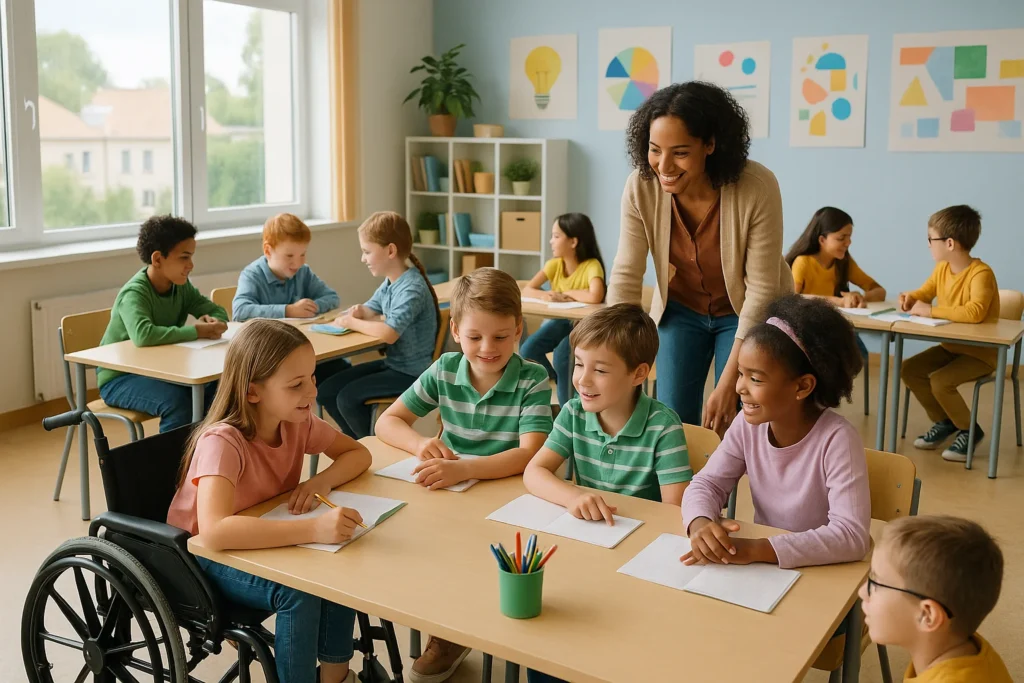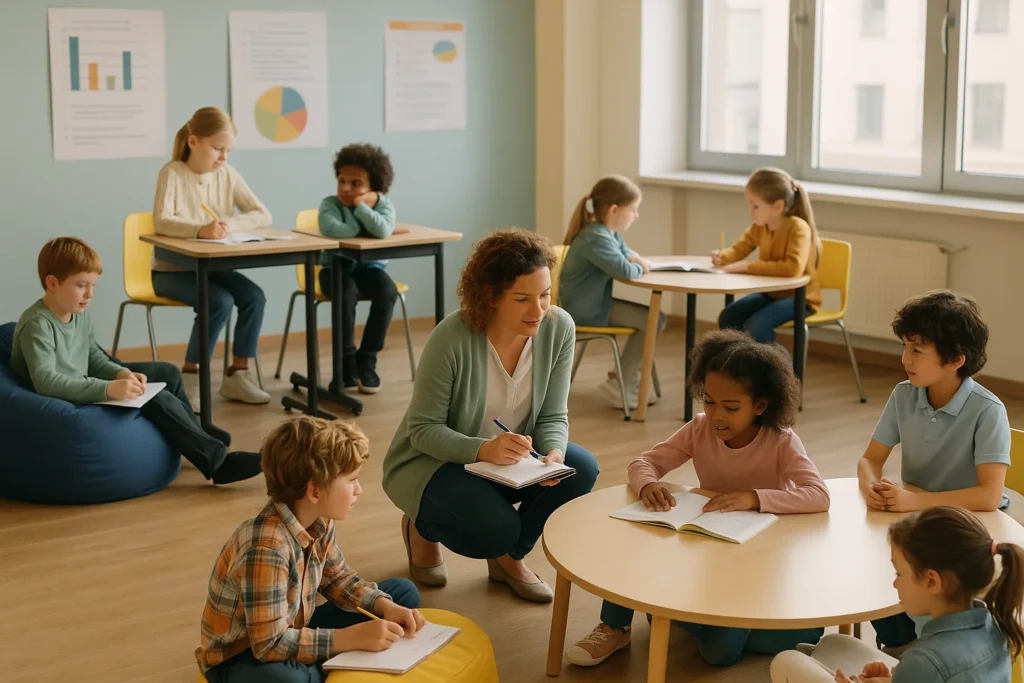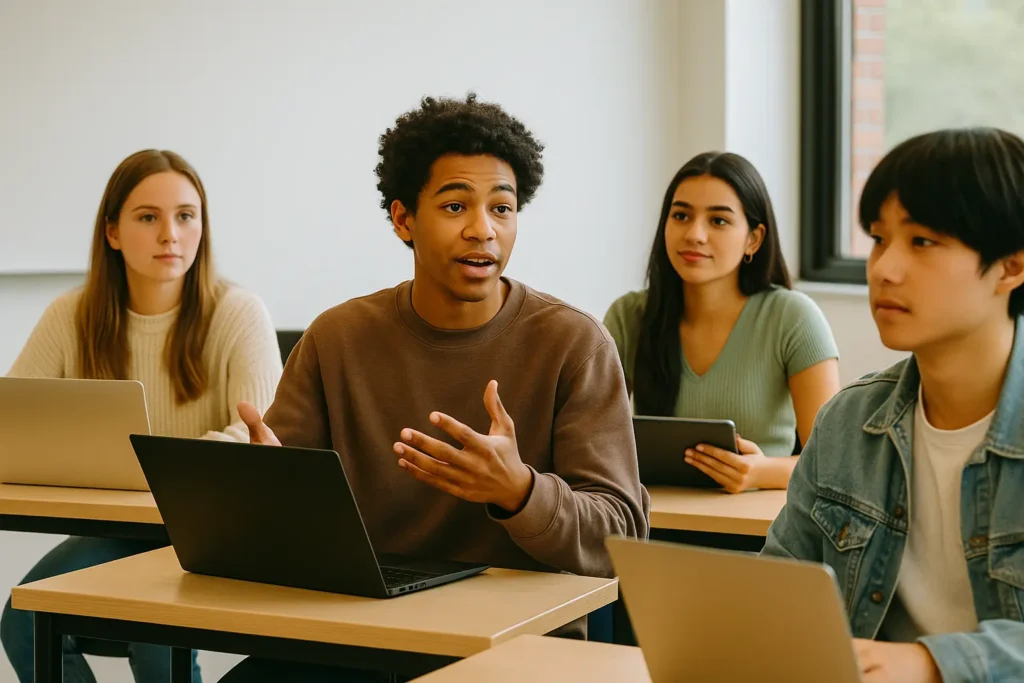What happens when you’re handed a room full of students with different needs, strengths, and learning styles, but no one gives you a game plan? We know it’s enough to make you feel lost.
Here’s the thing. Inclusive education doesn’t ask you to be perfect or have all the answers. Creating a space where every student feels like they belong is sufficient. That’s it.
With a few inclusive classroom strategies, you can make your lessons work for everyone without doubling your workload. In this guide, we’ll show you how to keep things simple, supportive, and actually manageable.
Let’s get going.
What Makes a Classroom ‘Inclusive’?
An inclusive classroom is a space where every student can learn, participate, and feel like they belong. It is built on purpose, with lessons, routines, and expectations designed to support different needs from the beginning. Inclusion means no student has to work harder just to be part of the room. Everyone starts with the same right to learn and contribute.

When students feel accepted and supported in an inclusive classroom, they engage more, grow in confidence, and are more willing to take risks in their learning. It reduces isolation, builds respect, and strengthens the class as a whole. Inclusion should be the standard, because no student should ever feel like they have to earn their place.
Now, people mix it up between “integration” and “inclusion”. Here’s a table to show you the differences.
| Aspect | Integration | Inclusion |
| Approach | Adding students with diverse needs to a general class | Designing lessons to meet a range of needs from the beginning |
| Timing | Adjustments are made after difficulties arise | Support is built in proactively |
| Student Role | Students must adapt to existing classroom expectations | Classroom adapts to support all learners equally |
| Teacher’s Mindset | “This student can join, but only if they keep up” | “Let’s teach in a way that helps everyone learn together” |
| Classroom Culture | Presence without participation | Belonging with full participation |
As one Year 5 student once said, “It’s easier to learn when I don’t feel weird for needing help.”
A teacher used to feel frustrated when one student always worked alone. After a group task was redesigned with clearer roles, that same student led the activity. “I hadn’t realised I was waiting for them to change,” she said. “Turns out I just needed to change the task.”
That is the heart of good inclusive classroom strategies. You adjust the environment so everyone can shine.
Inclusive Classroom Strategies That Actually Work
Now that we’ve cleared up what inclusion really means, let’s talk about what it looks like in action. Inclusive classrooms include flexible seating and collaborative learning as well as student choices in tasks. But there’s a lot more to it than that. Here are a few strategies for you that work in real classrooms every day:
- Flexible seating: Let students choose where they work best, such as bean bags, standing desks, floor cushions, or traditional chairs. Comfort can help focus.
- Visual supports: Use picture schedules, step-by-step task cards, and colour-coded instructions. These help students process information more clearly.
- Collaborative learning: Mix up groups based on strengths and not just ability. Give each student a defined role so no one gets left out.
- Choice in tasks: Offer options for how students show their understanding, like drawing, speaking, writing, or building something.
- Clear, predictable routines: These reduce anxiety and help all students feel secure and ready to learn.
A lovely example comes from Mr. Patel, a Year 2 teacher, who introduced hand puppets during circle time. There was a boy who hadn’t spoken loudly for weeks. He began using a puppet to answer questions.
Bit by bit, that puppet became a bridge between him and the class. Eventually, the student didn’t need the puppet to join in.
These kinds of small shifts help remove barriers before they become blocks. That is what inclusive classroom strategies are. You are giving every child a fair shot without turning teaching into a juggling act.
Voices That Matter: Listening to Students
You’ve set up flexible seating and brought in the visuals. Great start. But before you break out the gold star stickers, there is one more thing to check. Have you asked your students how it’s going? Because the student feedback is often the missing ingredient in inclusive classroom strategies.

Kids usually have no problem telling you what’s working and what’s a complete flop. You just have to ask the right way. You may try with questions like, “What helps you feel comfortable during lessons?” or “If you could change one thing about this class, what would it be?”
When asked, one Year 6 student replied, “I like when we do quiet reading after lunch because I feel tired and don’t want to talk yet.” Another said, “It’s annoying when instructions are only said once. I need to see them too.”
Inclusive classroom strategies are not fixed. They grow with your learners. And speaking of support, let’s talk tech.
Technology: Helpful Mate or Class Clown?
Technology in the classroom refers to tools like tablets, apps, interactive whiteboards, and software that support teaching and learning. In an inclusive classroom, it can be used to give students more ways to access content, such as text-to-speech for reading support or visual timers for routine clarity.
When chosen thoughtfully, technology helps personalise learning and boosts students’ confidence. But if it is distracting, hard to use, or only suits one learning style, it can indeed turn out to be a clown.
Tools That Actually Help
Some tech is fantastic for supporting inclusive classroom strategies. Tools like Text-to-Speech (TTS) apps help students who struggle with reading keep up with class content. Closed Captions (CC) support learners who are deaf or hard of hearing, and visual timers help students with time management and focus.
Programs like Immersive Reader, Google Read & Write, and Speechify are great examples.
Before adding something new to your setup, ask:
- Is it easy to use?
- Does it work across different devices?
- Will it help students feel more confident and independent?
What to Avoid
Here is a list of things you should avoid while considering tech for the classroom:
- Apps with long setup times. They will interrupt the flow of your lesson and waste your valuable teaching time. Subsequently, students will lose interest.
- Tools that rely heavily on internet speed. The school may have unstable internet connections or low speed. If these tools stop working or lose connections, it may make students feel confused and stop doing a task.
- Flashy distractions dressed up as “educational games”. They often rely heavily on colours and sound. Students may have a hard time regaining focus afterwards.
- Software that benefits just one learning style. An inclusive classroom requires strategies to work for all the learners. If it doesn’t work, then the classroom ceases to be inclusive. For example, if a software helps only visual learners, you risk leaving others behind, like auditory or kinesthetic learners.
Inclusive classroom strategies don’t require you to get the latest gadget. What you actually need is tech that fits the students and not the other way around.
Planning for Difference, Not Deficits
Lesson plans can make or break an inclusive classroom. Even the best tech will fail if the lesson itself only fits one kind of learner. Inclusive education primarily focuses on teaching in a way that recognises and uses students’ strengths.
This is where careful and flexible planning works well. But how to do it?
One smart approach for it is layered instruction. You start with a base task that everyone can attempt, and then offer extensions for those who need more challenges. These anchor tasks keep things steady, while layered options let students stretch without pressure.
For example, in a history lesson, all students might explore an event with a timeline, while others dig deeper by comparing sources or creating a short presentation.

Peer coaching also works well. Pairing students with different strengths, like one who’s great with visuals and another who’s confident speaking, lets both bring something to the table.
Micro-groups help as well. Instead of one big group activity, use smaller, rotating teams with clear classroom roles. One might be the “fact checker,” another the “notetaker.” This setup gives everyone a purpose, especially when linked to their strengths.
These are the kinds of inclusive classroom strategies that will help you inspire everyone to participate. But you have to plan for it before the teaching session.
Real Talk: Challenges and How to Handle Them
Let’s not pretend inclusive teaching is always a smooth experience. Even with great extra care and thoughtful planning, you’ll face obstructions. But working through those challenges is worth it because every student deserves a classroom that works for them.
Common Hiccups
Time is a big problem you will face. Adapting lessons may feel like it takes longer than just teaching the standard plan. Resources can be thin too, especially if you’re the only one pushing for inclusion. And then there’s resistance from colleagues, admin, or even parents who don’t fully get what you’re doing. But you have to overcome them all!
Speak Up with Confidence
When you need to advocate for support, keep things clear and focused. Here’s a sample script:
“I’ve seen real engagement from students since using these inclusive classroom strategies, but I could use some help with [insert resource]. Would it be possible to explore this together?”
Myth-Busting Moment
Let’s tackle three common myths:
- Myth: Inclusion slows the class down.
Truth: It often improves engagement for everyone. - Myth: Only special ed teachers should do this.
Truth: Inclusion is a shared effort. - Myth: It’s just about feelings.
Truth: It improves learning outcomes.
Remember Mr. Patel and his puppet from the earlier section of this article? That small change brought the whole class closer. Inclusion might feel tricky at first, but solving these challenges creates a better space for everyone. It takes a lot of heart to do it, and you have got it!
Measuring What Matters
If you’re putting effort into inclusion, it is worth checking if it’s actually working. Measuring what matters helps you see progress, spot gaps, and adjust your inclusive classroom strategies without the guesswork.

You should start small. Here is a simple way to gauge success:
- Step 1: Observe
Notice how students react to different segments of the lesson. See who’s participating, who seems disinterested, and who needs more support. - Step 2: Reflect
Ask yourself if your strategies functioned well. Think about what worked and what failed. Reconsider the setup, instructions, or task types of your strategies. - Step 3: Adjust
Make small changes based on what you noticed. You may need to add a new visual clue, change group roles, or offer further ways to complete a task. - Step 4: Ask Your Students What They Think
Casually check in with a quick question or have a friendly chat with your students. If you ask the right way, they can tell you what helped them, what confused them, and what they’d like more from you.
Use this quick reflection checklist during or after a lesson:
- Are all students participating in some way?
- Did I offer more than one way to complete the task?
- Were any students consistently silent or disengaged?
- Did anyone shine in a new way today?
Keep an eye out for small wins. Maybe a student who usually avoids group work has decided to volunteer to help a partner. That matters a lot.
Asking students how they felt during a lesson gives you additionally important information. When they know their voice affects the classroom, it builds confidence, comfort, and real trust. That is when inclusive classroom strategies turn into something bigger and successful.
Bringing Families Along for the Ride
Families play a big role in how included students feel. They are intrinsically connected to their children, provide emotional support to them, and are aware of their regular needs. So, when these families are on board, everything runs more smoothly.
Involving families in the process also shows that you care about the whole child and not just the bit that shows up for maths. You don’t need to do this alone. But how do you involve families?
Start with simple communication. It goes a long way. Weekly updates, a shared class folder, or even a quick photo from an activity can keep parents in the loop. Ask for their input too, especially when it comes to things like home routines or learning preferences.
Be mindful of cultural differences. Different families celebrate different holidays or view schools differently. And offering translated materials or adjusting classroom activities due to linguistic diversity shows respect and builds trust.
And remember, every take-home task doesn’t need to be dramatic. You’re not asking for a life-sized volcano model! A five-minute chat about the day works just fine.
You’ve Got What It Takes
Creating an inclusive classroom has its main focus on staying curious, listening to your students, and trying strategies that make learning feel possible for everyone. From flexible seating and peer coaching to student feedback and family support, the small adjustments we’ve covered in this article can lead to real change.
You don’t need to rework your teaching style overnight. Start with one or two inclusive classroom strategies and build from there. Your students will notice, and so will you.
If you’re ready to take the next step and want resources, support, or just a bit of inspiration, visit Francis Orr. We’re here to help you make your classroom a place where every learner can grow and shine.
And if you try one of these ideas, let us know how it went. We’re all in this together!





